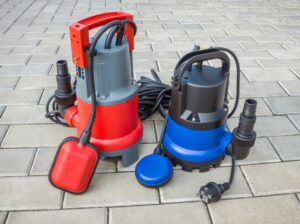Give us a call today: 416 663 4777 for a free upfront estimate!

Flooding and leaky basements are a big issue in Toronto. In order to waterproof your home, we offer a variety of methods to help protect your basement dry. The best defense is multi-layer defense and that is why all 3 methods can be used together to minimize the danger.
- Backwater valve installation. A backwater valve blocks the line from your house to the city sewer line, allowing water to flow out of your home but not to flow back up into your basement.
- Weeping Tile. This is installed outside or inside of your home, around the walls of your basement. Pipes carry the water away from the house, to a sump basin or elsewhere.
- Sump Pump. A sump pump installed in your basement will allow water to collect safely in a basin below your basement floor that is then pumped away from the house. We can install both the pump itself and backup power to ensure that if a heavy storm cuts off the main power, your basement is still protected.
What is a Sump Pump and Do You Need It?
Not everyone’s home needs a sump pump, so when you call us for your free, no obligation inspection we can determine if a sump pump is right for you.
A sump pump connects to your weeping tile and works by allowing water to collect in a basin or sump pit below the floor, and then pumping it back out again through the sump drainage system. As the water rises, the pump starts up and drains the basin through a system of pipes that empty outside, away from the foundation of your house.
How Does a Sump Pump Work?
So how does a sump pump keep the water out? A sump pump is usually positioned in a sump pit. This is a hole with a gravel base that is 18 inches wide and 2 feet deep. These are positioned in the lowest part of your crawlspace or basement.
As this pit fills up with water, the pump kicks into action. This is going to move the liquid from the pit through pipes that actively run away from the home. Here the water can drain away without damaging the foundation. The pipe used usually has a check valve at the pump end. This one-way valve can prevent the water from flowing back into the pit.
Installing Your Pump
In order for a sump pump to work correctly, it needs to be installed by a licensed professional plumber. We’re able to not only do the work and connect it to your weeping tile, but we can locate the right position in your basement for optimal flood prevention. Also, choosing an expert from Dr. Pipe for your installation means you can qualify for City of Toronto rebates which can drastically offset your costs.
Choosing the Right Pump
Most pumps are automatic and run on a power supply but there are manual pumps that you can control yourself. Manual pumps can be cheaper, but we would recommend an automatic pump in most circumstances. Other factors to consider when choosing a sump pump include horsepower, voltage, cord length, and backup power, in case a storm knocks out the main power. There’s so much to consider but we’re here to help and determine not only if you need a sump pump, but what kind will be most effective in your home.
There are a number of different sump pumps available. Depending on your needs and your residence, the one that is right for you may vary. These are the different types of sump pumps:
- Primary – Most homes throughout North America will need this type of sump pump. These prevent floods by pumping seepage water out of your basement. There are two different types, pedestal pumps and submersible pumps.
- Battery backup – In the event that the power goes out, these provide you with some added insurance. Because most sump pumps are electric-powered, a power outage will render them useless, even though this is when you need them the most. These still provide the same benefits as the primary option, but with the added benefit of kicking in if the power goes out.
- Sewage pumps – These are unlike the traditional sump pumps. The primary goal behind these is pumping effluent and sewage waste from a home to a septic system
What Does a Sump Pump Cost with the City of Toronto Rebate?
Every situation is different but if you call us for a free, no obligation inspection we can work with you to figure out the best system to fit your needs and budget. We’re also able to help you with the City of Toronto Flooding Protection Subsidy Program which offers you substantial rebates for flood prevention work. Our team of experts can help fill out all necessary forms so that you get the most value and install your sump pump the right way.
Sump Pump Maintenance
If you expect your sump pump to keep working, you will need to perform routine maintenance on it or have a professional do so for you. Oftentimes your sump pump will not be used for months, this is one of the reasons it is a good idea to have a professional take care of maintaining it for you. The last thing you want to do is realize that your sump pump does not function as it should during a flood. We highly recommend you to perform both seasonal and annual sump pump maintenance.
Why Dr. Pipe?
We treat your home the way we expect workers to treat our homes. That means coordinating with you from the moment you call for a quote all the way through the final work we perform. Our team will cover and clean everything in their work area so you don’t have the added stress of a mess to tidy up and we’ll finish as quickly and efficiently as possible.
We can also help with insurance and obtaining any permits or the potentially valuable, cost-reducing City of Toronto rebates that you may qualify for when you hire a licensed and insured company like Dr. Pipe.
Give us a call today: 416 663 4777 for a free upfront estimate!




